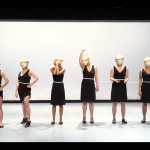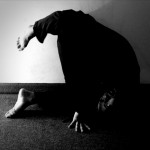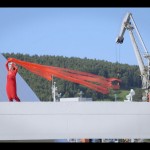Артисти 2018
what now /
/ постер
постер /
/ артисти
артисти /
/ програма
програма /
/ снимки
снимки /
/ видео
видео /
/ места
места /
/ партньори и приятели
партньори и приятели
Sofia Underground 2018
what now / now what
26-29 април 2018
Изложба – Видео документация на пърформанс арт:
02:00
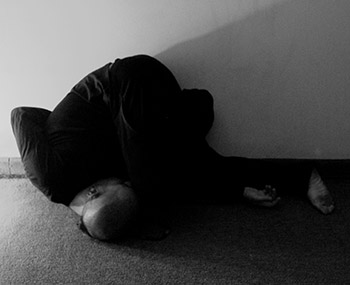
BICHO is an experiment of physical strategies with a state of latent transmutation, with no apparent results or objectives, other than the very wear of the performer, that fulfils the duty of adaptation and confinement within a domestic space, considered as a temporary scenario for a manifestation of state. The work results from a research on nocturnal insects and their obsessive and restless movements by artificial lights (confusion of the naturally oriented by the moon), constantly perceived in the artist’s studio – place of performance, filming and digital manipulation of this video.
Felipe Bittencourt
Rio de Janeiro, RJ / 1987
Lives and works in São Paulo, SP
Visual Artist, Bachelor in Visual Arts at the Centro Universitário Belas Artes of São Paulo, 2007, specializing in Photography at the Pan American School of Art and Design, 2010. Mainly works with performance and video, also using drawing as a base language for research and development of his works, along with the use of photography and video in the exploration of his own body, the puvlic space and the social media. Inhis works, he investigates the physical limit and as a poetic possibility questioning the body as artistic support in digital manipulations. His works were presented in different festivals and institutions, such as Videobrasil (2015/2011) Verbo, Galeria Vermelho, São Paulo (2013); Paço das Artes, São Paulo (2013); Brazilian Museum of Sculpture, São Paulo (2011); Arte Pará, Belém, Brazil (2008 -Acquisition Award); among others. He also participated in residencies at the Joaquim Nabuco Foundation, Recife (2014) and Red Bull House of Art, São Paulo (2011).
09:45
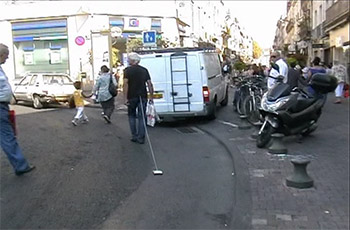
In this performance for two days I walk the streets of the city of Sete in France. I am walking with a hard disk, which is bound by a chain for my belt, and I pull it from the rear as a tail. I’m walking down the streets, markets, shopping centers … etc. My unexpected behavior causes people to stop, the expectation is rewarded, because I, in the end, offer artwork on paper, one who dares to take it. I put colors on a hard disk that I print on white sheets and I share them with viewers and random passers-by.
Born in 1955 in Odzaci, Serbia (Ex-Yugoslavia).
Freelance visual and performance artist, publisher and curator.
Member of art societies of Vojvodina (SULUV) and Serbia (ULUS).
From 1984 to 1988 founded and published alternative international art magazines “Total” and “Second Manifesto”.
Curator of various international art projects and exhibitions since 1980. 1998. he founded of Multimedia Art Studio and MAS Gallery in Odzaci, Serbia. Organiser and curator of International Multimedial Art Festival – IMAF.
Since 1980 Nenad realized his over 250 art performances and art actions on many international art projects and festivals worldwide (France: 1994, 2011, 2012 & 2013, Italy: 1995, 2003, 2004 & 2011, Slovakia: 1996, Germany: 1996, Japan: 1997 & 2008, Romania: 1998, Poland: 1999, 2007, 2010, 2012 & 2013, Hungary: 2001 & 2011, Belarus: 2001, United Kingdom: 2004 & 2010, Northern Ireland: 2004 & 2011, Switzerland: 2004, USA: 2005, Canada: 2006 & 2008, Turkey: 2007, Israel: 2007, and in Serbia (since 1980).
Realised art tours with Man Gallery project in France 1994, Italy 1995, Germany 1996, Japan 1997 and Switzerland 2004.
In 2003 year realised two art performances on 50th International Biennial of Venice-Italy (International Art Project: Brain Academy Apartment).
25:55
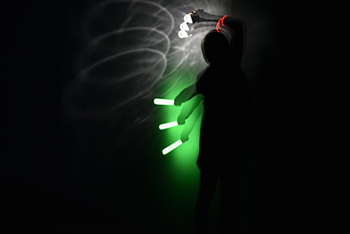
Sounds Eerie is a participatory sound composition by Brigitta Bödenauer which uses recordings gathered during a workshop that focused on feelings of isolation, alienation and estrangement in everyday life. The artist and the workshop participants explored how those feelings could manifest themselves in the city’s soundscape by recording sound samples with their smartphones.
As a starting point for such a collective sound practice served both the artist’s own work and other examples taken from film and video art collection of WRO Art Center.
The intimate sonic images gained a universal relevance by becoming building bricks for Bödenauer’s composition. She deconstructed their original narrative structure by selecting and alienating micro-sounds, condensing them or stretching over time.
The outcome of the workshop was an experimental live act carried out in the gallery space together with the workshop participants and invited guests. The live-mixed composition was accompanied by improvised performative exercises that revolved around the notions of sound, space, light, darkness, movement, presence and isolation.
The Wrocław-based video artist Mira Boczniowicz has documented the performance, creating its unique visual materiality.
The project was made within the artist-in-residence program at WRO Art Center under the curatorial cooperation of Agnieszka Kubicka-Dzieduszycka. It was supported by the Austrian Cultural Forum in Warsaw and the municipal Artist In Residence Programme AIR Wro run within the framework of the European Capital of Culture – Wrocław 2016.
Credits:
workshop participants, co-authors of the composition: Brigitta Bödenauer, Wojciech Furmaniak, Katarzyna Kaczmarczyk, Paweł Kreis, Agnieszka Kubicka-Dzieduszycka, Lillianna Leń, Barbara Pigoń, Anna Wawrzyniak, Agnieszka Żerdecka
cooperation: Paweł Kreis
Performance documentation:
concept & camera: Mira Boczniowicz
additional camera: Maurycy Wiliczkiewicz
editing: Mira Boczniowicz
production: WRO Art Center
TRT: 00:25:55
Brigitta Bödenauer (AT), born in 1972, has graduated in Theater, Film and Media Studies from the University of Vienna. She teaches and writes on film and visual media. Bödenauer has been active as DJ in Vienna’s noise and experimental scene since the early 1990s. Her visual work has always been inspired by and strongly connected to music. Extensive experiments – driven by her fascination for the sensuality of movement and material – mark the beginning of each of her works. She creates fleeting spaces by employing various acoustic and/or visual means often addressing the intangible, the hidden, or what eludes perception. She has collaborated with musicians, such as PRSZR (Rafal Iwański, Pure), CoH (Ivan Pavlov), Miguel Carvalhais, Susanna Gartmayer or Peter Kutin. Her films received a number of awards, including the First Prize at the 2004 Diagonale Festival in Graz in the category Innovative Cinema, and the Best Abstract Film at the London International Animation Festival in 2008.
Artist’s website: bb.klingt.org
The WRO Art Center is since 2008 a community-oriented place for research, production, presentation and documentation of contemporary art practices with focus on media and communication technology. Its program of exhibitions, screenings, performances and workshops, directed to different strata and groups of audience, supports artistic and educational activities, and initiates intellectual interchange. The Center emerged from the WRO Media Art Biennale, which is Poland’s first event of that kind (since 1989), the 17th edition of which took place in 2017. The rich audiovisual documentation of the successive editions of the WRO Biennale, including recordings of exhibitions, installations and performances as well as video art pieces and interviews with artists, accessible offline and partially online, makes up the core of the WRO’s media art collection.
More: wrocenter.pl/en
Facebook: www.facebook.com/wroartcenter
60:14

A documentary exploring the importance of time and duration through Amanda Coogan, the Dublin-born performance artist who has been a close student and collaborator with Marina Abramovic throughout her career. Filmed during a gruelling six-week exhibition at Ireland’s prestigious RHA Gallery, the hour-long documentary follows the artist as she prepares for and performs daily for six hours a day, five days a week.
Capturing what was the gallery’s most successful and visited show in its 187-year history, the film weaves together the beautiful live performances with Coogan’s off-screen reflections on the physical and emotional demands of her art and why her Deaf family background and Sign Language in particular is often the inspiration for a movement or performance.
I am a documentary director primarily making films about art and architecture.
In 2016 my documentary Seán Hillen, Merging Views won best short documentary at Galway Film Fleadh and screened at many other prestigious film festivals as well as on RTÉ’s Shortscreen. In 2017 my new feature documentary Amanda Coogan: Long Now premiered at the Audi Dublin International Film Festival. The film profiles the renowned Irish artist, and has since had many more screenings including at the Irish Film Institute, around Ireland, and internationally.
I am a member of The Screen Directors Guild of Ireland, The Irish Architectural Archive, DoCoMoMo Ireland, and Visual Artists Ireland.
08:38
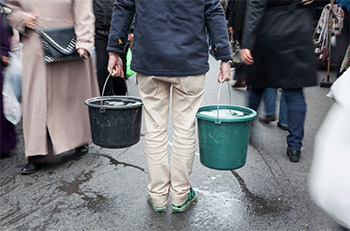
Starting from the linearity of the street and the difficulty to remain motionless in the market’s crowd, the research consisted in the accentuation of the milling crowd and the surrounding commercial activities.
Staying still would be to temporarily – and symbolically- deny the ambulatory purchase act. As well as accentuating the surrounding human activity. The fixed sequence shot pushes the spectator to think away from any narrative aspect, and ask himself about what is left : the context, the human stream and the details, in sound and image. By a simple performed act, the water bucket becomes a resonance chamber of the crowd moves. It also represents the most basic good, in the simplest way to carry it. The video tackles the political and social question of the accessibility to water, without being intentionally. That is, by approaching the subject obliquely and preferring poetic evocation to the polemical claim. It is therefore ‘taking a position’ both spatial and poetic, and becomes therefore political – as the artist in the market space.
Furthermore the construction of the image is sort of a reversed American shot where the soil predominates, whereas the water reflections open-up the off-field. It shows the blurred surroundings of the market place as well as a few faces. The reflections contain the reality that the frame of the image doesn’t show.
The duration of the video is defined by the resistance time to the buckets weight. The act performed in public space defines the length of the video. It is a video work based on a performative site-specific intervention – as it as been thought as such. The video and the performance act are intrinsically linked : the video being the only way the performance lasts in time and therefore can be shared.
Arthur Cordier
Born in Leuven, Belgium, 1993.
09:57

Part of the cycle “IT WON’T ALWAYS GROW BACK”
with teenagers from tjg. theater junge generation
06.10.2017, Albertinum – Staatliche Kunstsammlungen, Dresden, Germany.
In cooperation with: ACT.MOVE.PERFORM., Freiraum Albertinum, tjg. Theater Junge Generation
Camera, Sound, editing: Matthias Pick
Art can be just beautiful, enticing, formal or simple. (The artist must not be beautiful). Art can be just
this magical visual sensation which appears when Yellow and Blue melting together – creating Green. This visual process has no purpose, deeper meaning or direction where we ought to find understanding. But this simple, elemental color union is able to trigger thousands of topics, stories, themes and concept without actually mentioning them. Art is not made to be understood in a logical way to place it
somewhere in shelves of understanding and verification. If you try to logically understand my art you will simply destroy it before it can unfold its true nature.
I also don’t understand my art and I am sure that I will never be able to put the ‘meaning’ or ‘sense’ of my performance images into words. (Perhaps in poetry only). I am already here placing colors, forms, compositions again and again into dialogue and see the appearing tensions and possibilities. This is already a universe, this can be it. It is like having the paradox as a constant companion which guarantees no solution, no result, no answer, no arrival – but an exciting journey to one’s own visual memory. It is not about what you see. It is about what you don’t see. To activate this access is my personal and artistic wish.
06:20

In an age of immanent environmental disaster, the young start-up Climate Corporations have made it their mission to promote an “affirmative approach to climate change“, propagating partying in the face of global catastrophe as a valuable and pro-active coping mechanism. Climate Corporations are breaking down the unproductive juxtaposition of humans and climate; their explicit aim is to minimize the everyday impact of restrictions borne from ecophobic thoughts and behaviors. In the process they have reduced climate change to its exploitable market value: an explosive topic of global relevance that is as ubiquitous and existential as it is lucrative and, indeed, “sexy“, especially when considered in the context of the time-honored combination of catastrophe/pre-apocalypse and excess/hedonism. In an attempt to ingratiate themselves with their millennial target market, Climate Corporations have originated the particular combination of environmental disaster and club culture by putting on so-called “climate parties“. A few vodkas down the line, even the most cynical members of Generation Y will become roused by contemporary topics of global relevance – enter: climate change – while bemoaning that they simply “cannot relate“ to existing initiatives like WWF, Greenpeace or The Climate Group. Climate Corporations’ parties are a decidedly anti-activist, anthropocentric way of engaging with environmental Armageddon. Momentary euphoria as an antidote to crisis! High-powered surrender instead of paralysis and despair! CLAIM CLIMATE CHANGE – YOU’VE EARNED IT!
LIKE THERE’S NO TOMORROW is both an immersive performance installation and a satirical social experiment: 60 minutes of hardcore partying against a backdrop that treads the tightrope between climax and ecstasy, and escalation and crash-and-burn. Climate Corporations’ parties establish a space dedicated to performative engagement with aestheticized aspects of climate change, exploration of corporate greenwashing strategies, and the phenomenon of eco-anxiety.
The film is a montage of footage captured at a climate party in January 2018 in Berlin-Neukölln.
Jos Porath (www.josporath.com) creates immersive installations. Their interdisciplinary practice can be understood as an investigation into the lure of dystopias, as well as an ongoing social experiment on accountability, self-determination, boundaries and vulnerability in non-traditional immersive formats. Jos’ audio-visual installations have been shown at galleries in Berlin and London including The Tanks at Tate Modern; they have directed a number of sold-out immersive performance installations in off-site venues and at several international (performing) arts festivals.
Melody Pasanideh studied Philosophy and Scenography in Vienna while also working at cultural institutions including the Burgtheater and Volkstheater. Her practice is informed by intellectual and artistic musings on existentialism and surrealism alongside critical observations of societal power hierarchies and global mass media manipulation. Melody is currently based in Berlin, Germany where she realizes immersive installations as director, scenographer and performer.
Jos and Melody met when they were working with renowned performance collective SIGNA in 2016. LIKE THERE’S NO TOMORROW is the second production that they are realizing together.
www.climatecorporations.org
www.facebook.com/climatecorporations/
10:21
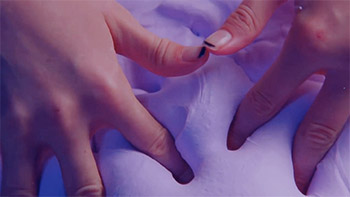
It is the world of a rushed man. We see a body as “the center of our contemporary tensions”, which is explored on its path towards “posthumanity”. The body is subjected to a mutation that invests its sacredness and that comes to destroy the idea of skin as a place of con-tact-separation between the Self, the Other and the World. The post-organic body is not represented exclusively in its most fascinatingly aesthetic dimension. A post-organic unity is this hybrid moment between meat and prosthesis, between living matter and the artificial one that allows the reversal of human potential during one’s existence. I think it is a focal point for the collective imagination, the organic-inorganic-post-organic association. The work on the contemporary body, is not a romantic cry, an alienation complaints, an existential protest turned on the negative, but rather it is further elaboration in the direction of an “anthropological mutation” that is critical, yes, but simultaneously positively addressed . Moreover, the work on the contemporary body is essentially about questions related to the relationship between body and technique, to new forms of the body and new figures of technique, to great difficulties and discomfort but also to new horizons of contemporary technique. Precisely from the observation of the environment and of the daily behaviors that move within it, the possibilities arise to create visual hyperboles. << We must accept the fact, very painful, that some questions are no longer asked >> writes Nicolas Bourriaud. What is the relationship between art and society, history and culture? Where does our obsession about interactivity come from? After the consumer society and the era of communication, art still contributes to the emergencies of a rational society? How does art resist the prevailing homologation?
Lie-fi Palimpsest is an artistic collective directed and coordinated by Rossana Bossini and Floida Skraqi. The research of the collective explores the nature of the performative event and discusses the mechanisms hybridizing word, image, the relationship with the architectural spaces, the connection with the natural and the urban habitat: an interdisciplinary process, where the result is both process and product. The focus of the research is the Collective body that exists in the Territory but is reflected in the Individual Body as flesh, desire and expression of individual freedom.
Ritual, Myth and Holy, are tools through which there are identifed new “roads” to go, which in turn lead to the subversion of the rules, the creation of new social subsets that define new hierarchies, new spatial definitions, new divisions between inside and out. Here, on the Border, acts our artistic experimentation.
Rossana Bossini, Brescia 1981. Graduated at the Brera Academy of Fine Arts with an experimental thesis at the Atelier of the Psychiatric Center of Melegnano (MI) with the project L’Altrove – Matrici, orizzonti geografici e mappe interiori. Since 2014 she has been involved in politics as a council member of Culture, Education, Sport and Equal Opportunities in the Municipality of Lumezzane. She also deals with teaching and holds artistic workshops aimed at different targets.
Floida Skraqi, Lushnje 1989. She graduated in Visual Arts at the Brera Academy of Fine Arts with the project “inOrganik” financed by the Order of Malta, presented in the Deshmise dhe Kujtese Museum, Shkoder, Albania. Since 2006 she has been active in theater and performance art. She carries out educational workshops in museums and municipal institutions in Teviglio, Milan and Brussels.
07:55
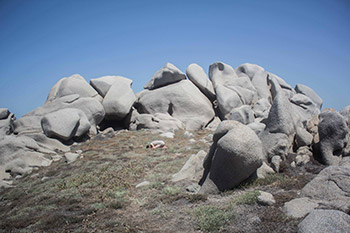
Municca is the result of a magical and mysterious experience, that experienced in June 2016 in Santa Teresa Gallura thanks to the precious support of Teatri Peregrini Festival. Every day, for a week, we walked on foot, between myrtle and heat, between silence and sea breaths, that stretch of wild and hidden coast that leads to the open sea, until the final performance, Fase di dormienza (The dormant stage), a study about seed as a primary generative cell, between conservation and transmission, between tradition and betrayal, between searching for quality and quantity demand. A survey on biodiversity, both natural and cultural.
The seed as a subject of observation, as a container of specific identities, as a distinctive sign of a people, a matrix of an extinct language.
When mature the seed enters a quiescent or dormant phase during which all vital functions are suspended to be restored when conditions favorable to germination occur.
It’s in this form, a starting point that precedes and envisages a possible unpredictable development, which the body becomes a means of investigation.
Fase di dormienza is a project born of the encounter with a territory, its inhabitants, its rituals, its times and its first stage in Sardinia during the event Geografie Sommerse 2015.
The project seeks to translate the sense of the uniqueness and complexity of the seed to the body, also understood as a complex and compact system that relates to a space and a land, the search for a symbiosis between places and people.
Municca is facing the boundaries, losing the contours. Island inside island, Municca, Santa Teresa Gallura. Corsica on the horizon. Wind and granite as travelling companions. Enduring the phase of dormancy with the blazing sun, between tracks bleached from the sea, the eroded thought, in touch
with forces that do not want (more) to know about human being.
Concept, film, editing, sound: SALVATORE INSANA
With: ELISA TURCO LIVERI
Production: DEHORS/AUDELA
With the support of Teatri Peregrini – No Borders Performance Art Festival 2016
06:05

“The Sign” (2017) is a 60 minutes performance that explores visual culture of shame in relation to the body, subjects and power in contemporary performance art. In this work, eight female performers are tied together with a rope. They wear masks, standing and repeating some symbolic gestures. They hold each gesture for two minutes and then move to the next one at their own paces.
This work examines the visual culture of shame in its personal and socio-political dimensions, deconstructing the experience of shame through gestures and movements. It questions how shame is encouraged within societies that reproduce capitalist and power relations, and how it is used as a tool not only to exert control over the body but also to marginalize certain group members. I consider feminism, globalization and psychoanalysis, positioning shame as a feminist strategy of resistance—an ethical practice that seeks altered states of consciousness that possibly leads to restore dignity and humanity.
Performed by Alida Esmail, Lucy Fandel, Emma Lee Iversen, Alex MacLean, Kim L Rouchdy, Eryn Tempest, Emilie van der Waals, and Mary Williamson.
Chun Hua Catherine Dong is a Chinese born Montreal based visual artist working with performance, photography, and video. She received a MFA from Concordia University and a BFA from Emily Carr University Art & Design in Canada. She has performed in multiple international performance art festivals and venues, such as, The Great American Performance Art in New York, Rapid Pulse International Performance Art Festival in Chicago, Infr’Action in Venice, Dublin Live Art Festival in Dublin, 7a*11d International Festival of Performance Art in Toronto, Experimental Action/ Performance Art in Houston, ENCUENTRO Performance in Santiago, Internationales Festival für Performance in Mannheim, Place des Arts in Montreal, Inverse Performance Art Festival in California, Miami Performance International Festival, Visualeyez Performance Festival in Edmonton, M:ST Performance Art Festival in Calgary,and so on.
She has exhibited her works at Quebec City Biennial, Kaunas Biennial in Lithuania, The Musée d’Art Contemporain du Val-de-Marne in France, Canadian Museum of Immigration, Art Museum at University of Toronto in Toronto, The Aine Art Museum in Tornio, Museo De La Ciudad de Querétaro in Mexico, and so on. Her video work has been screened in Brazil, Mexico, Finland, Germany, Italy, Ireland, Colombia, Spain, The Netherlands, Finland, Poland, Greece, Romania, Croatia, Denmark, Sweden, Scotland, China, USA, and Canada. Among many other awards and grants, she is the recipient of Franklin Furnace Award for contemporary avant-garde art in New York in 2014. She is listed the “10 Artists Who Are Reinventing History” by Canadian Art Magazine in 2017 and ‘‘Top Nine Political Art Projects of 2010’’ by Art and Threat magazine.
06:47

LIQUID ESSAY underlines the direct association between flesh and pain, guts and sacrifice, following its motherproject “Tripas Coração”.
Tripas Coração, from the portuguese proverb “Fazer das tripas coração“ which means turning adversities into strength or making the extra effort to achieve something we truly desire, is a sculpture project that combines various techniques and materials, exploring the shape and texture of the gut of bovine animals. In Oporto, this visceral matter, which is usually associated with repulsion, is a symbol of altruism and sacrifice, proving that the virtue of things does not come from its origin. Indeed, in the most negative realities it is always possible to find clarity, as the main premise of this project, which, paralleling with an unstable and tumultuous paternal relationship, tries to transform the adversities and traumatic experiences, represented by the crudity of the guts, into force.
A mask in this visceral exteriorization appears, an object that in many ways has interpreted a crucial role in the development of the understanding of “what does it mean to be human” (transporting us to different identities, social or spiritual), covers the face of an immobile subject petrified by the incessant struggle between the interior and exterior, human and animal, exalted, however numb. The scarlet red mask acts as a raw and violent element, but at the same time humanizes this enigmatic, faceless being and exposes its anxious fragilities.
Joana Falcão (Matosinhos, 1992) is an emerging portuguese plastic artist based in Oporto, Portugal. Her artistic training began in ceramics which lead her to a bachelor degree in sculpture at the Fine Arts Faculty of Porto University. Her artistic journey includes exhibitions and participations in national and international biennials. She joined the EMERGE – Contemporary Art Agency (PT) catalog of Portuguese Emerging Artists 2017 and received from the Porto University/Santander Bancsponsorship in her participation in La Biennale di Venezia 2017.
Her artistic practice is autobiographical and aims to create a subjective, yet tense, dialog on human fragility and trauma as an instigator of artistic creation. It is from it that she seeks the emancipation of her own identity as a woman and creator.
Rita Morais (Oporto, 1992), studied Audiovisual Creation and Theories of Art at the Fine Arts Faculty of Lisbon University. In her work, she has been researching on a theoretical and cinematographic way concepts related with the notion of subjective/objective time and its possible approaches through film, inclusively how they might represent possible ontological turnings concerned to the act of seeing. She is also a film programmer in the city of Oporto.
02:53

Mehdi FARAJPOUR began as a theatre and dance artist but now is considered a conceptual performance artist. His artistic career covers many fields such as Dance, Theatre, Installation, Poetry, Photography and Video.
He is the Artistic director and main choreographer for ORIANTHEATRE Dance Company with 10 shows. He is also founder and general manager of Paris Summer Academy.
For many years he has regularly collaborated with international dance & theatre companies and festivals around the world e.g: IMPULSTANZ festival (Vienna), Istrian national theatre (Croatia), Wroclaw National Museum, Sopot National Gallery (Poland), Institut du Monde Arabes (Paris), CRICOTEKA (Tadeusz Kantor’s museum in Krakow),
TANZFAKTUR (Cologne, Germany), RAMDAM, Un Centre d’Art (Lyon, France), SOLO festival (Moscow, Russia),…
00:54

Video-performance Schwarmbeen at Gallery Vassli Souza in Malmö, during the Malmö-Foto Biennial event in 2007.
I usually build up characters to my performances, i have done that one during one workshop at the Berlinerfestspielle’s performance festival Foreigners affairs in 2015, with the German artist Johannes Paul
Raether. At the occasion we was inspired by his Futurist Drag queen aesthetic and with bicycles gums and red painting we’ve build each one the clothes and we made a Group like the animals grouping together and walking in the streets. After a while i,ve decided to develop more the Clothes and do it myself alone at one photo festival that performance a cause of i think it was appropriate. I was walking with an self stick and taking selfies with the public in allusion to the festival.
Sérgio Augusto lives in works in Malmö, Sweden.
http://dolls.segio.se
www.facebook.com/segiogio
www.segio.se
10:00
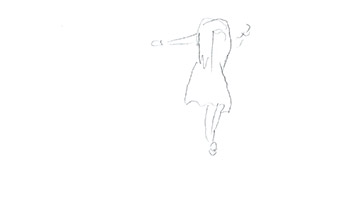
I hand drew each frame of the video documentation from the performance I’m Fine performed at Le Lieu, centre en art actuel in Québec, Canada. The performance documentation that I animated was shot by Patrick Dubé. It took me approximately three hours to animate five seconds. The documentation is 24 frames per second and is 8 minutes and 45 seconds long, a total of 507 seconds, and 12,168 drawings. I am interested in examining why the collective understanding of what defines a contemporary audience or performer continues to shift and blur. This entails a consideration of the multiple attempts throughout history to abolish the separation of performer and audience. To confront the residue of trauma, you must be willing to face insanity. Memories come in waves, never chronologically. I’m Fine reflects the experience of lived trauma.
Sarah Hill lives and works in New Orleans, Louisiana. They have shown nationally and internationally. Sarah has performed at Le Lieu The Contemporary Art Center in Québec, Canada, at the International Performance Platform Festival in Lublin, Poland at Gallery Labirynt, and at Performatorium 2014: Festival of Queer Performance Regina, Saskatchewan, Canada. Sarah received their MFA from the Museum School in partnership with Tufts University, Boston. They have studied with Black Market International at the Festival of Live Art in Glasgow, Scotland. They have performed at Mobius, Proof Gallery and Anthony Greaney in Boston, Grace Exhibition Space in New York, little berlin in Philadelphia, Living Arts Space in Tulsa, Waterloo Center for Arts in Iowa, The MACC, Austin, São Paulo-Santos, Brazil and Casino Luxembourg Contemporary Art Forum, Luxembourg. They have screened videos in Australia, Berlin, Canada, MIX COPENHAGEN, London (FRINGE! Queer Film & Arts Fest) Miami, New York (The Armory Show), Venice Bienale, Italy, North Carolina (NCGLFF) Portugal, San Francisco (SFTFF San Francisco Transgender Film Festival), and Scotland. Sarah has worked on projects with William Pope. L (Cusp) and Roderick Buchanan (Swim).
15:44

PEI-LING HO was born in Taipei, Taiwan with a complex cultural family background. She is studying in School of Visual Arts with an MFA in Fine Arts. Through performance, video, photography and mixed media, PEI-LING
explores questions of gender identity and perception within various contexts, ranging from the conflict between exotic and local culture and the legitimacy of parents under social system, and drawing from her experience growing up in Taiwan.
She has had group exhibitions include SATELLITE ART SHOW in Miami, WET. Performance Art Night in UK, WÄRMFLASCHE EDITION 2017 in Berlin, 29th Festival Les Instants Vidéo in France and more. Recent reviews and features include People’s Photography, The News Lens, The Reporter and more. PEI-LING currently lives in Manhattan, New York.
24:26

Amor Fati is a series of interviews where the author talks about performance art with a number of established Bulgarian artists. The footage is collaged with quirky visuals and sound by Georgi Ruzhev.
Born in Tchirpan in 1955, he lives and works in Sofia. He studied with Joseph Beuys at the Art Academy in Düsseldorf, Germany, from 1982 to 1986 before continuing his studies in Italy, the US and Greece. He is co-founder of the Der Meteor artists’ society. A major theme in his sculptures and installations is “Mankind, history and perception”. His first show was held at the Eleni Koroneou Gallery, Athens, in 1988. Since then he has had various commissions and exhibitions throughout Europe. He is currently a teacher at the National Academy of Art in Sofia. His motto as a sculptor is: “What you get is what you can’t see.”
11:18
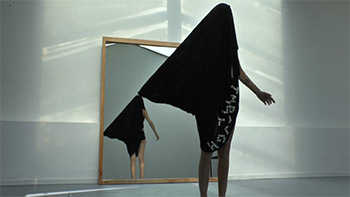
Performance and concept | Marta Lodola
Duration | 6 hours
Event | 20.ZINNOBER Hannover, Ilka Theurich Studio, 2017
Curator | Ilka Theurich
“Thank you”
I know it wasn’t my fault
if you grabbed me by the neck,
I know it wasn’t my fault
if you slapped my right cheek,
I know it wasn’t my fault
if you pushed me to the floor
I know it wasn’t my fault
if my collar bone was nearly broken.
Even when you locked me in our house I was sure that this was not the end.
In those moment I learned how huge my fears are,
and how they are sometimes strongly connected to love.
It’s strange, don’t you think?
After that I was not able to love anymore.
But that was not my nature,
because I’m made of love, light and darkness.
Now, more than four years and a half later
I want to say thank you for what you’ve done,
because leaving you gave me the power to be stronger.
Marta Lodola, part of ARISE, 2017
According to Michael Foucault, french philosopher and historian of ideas, since the beginning of modern society every individual has been subject to the control on its own sexuality. The takeover has permitted the repression of life itself. Every single human being has being under control of psychiatrists, priests, doctors, judges, law enforcement but also by families themselves. With the creation of the notion of population, a new necessity to fully control the masses has emerged. Through the practice of confession, the sovereignty took over the most intimate part of every
individual, repressing what was considered abnormal, not ordinary.
Highlights are present along our path in a way or another, and the resulting seizure of power on our being can shape in a positive or negative way our life. Often we found ourselves subject to be influenced by relationships, education, cultural dynamics but also by all the experiences we interface with during our existence. Specific external factors reflect within our inner reality, and for this reason we might get the chance to overcome our fear and discover a new reality free from obligations.
The act of sewing traditionally belongs to my life as my mother and my grandmother taught me how to sew buttons when i was a child. I used to fill up a piece of fabric then remove everything and start over again, choosing every day different and funny buttons. I’ve sewn the same piece of fabric over and over, a pocket made of red velvet. Growing up i’ve learned different sewing techniques, finding connections and similarities with painting and artistic creations in general. I keep with me this gesture as a unique sign of my persona and my femininity.
At some point, the joy and the naivety of being a child has been interrupted by a tragic event: a former partner has forced himself on me pushing me to find the strength and the lucidity to understand what was happening and finally leave him. In that moment I think I’ve lost, at least in part, the innocence in me that I might have never found again.
Luckily it was not as i thought, and after time I’ve understood the enormous pain i was carrying inside and I’ve decided to look for that child again and keep her with me. My artistic research has provided the lucidity to see things for what they are, detaching me and giving a wider vision.
I’ve found love for myself and for others only by leaving behind my old self made of forced social dynamics and conjectures as a woman. I’ve discovered gratitude for a life of complete faith. The negative experience turned into an unmistakable sign of my true self.
I’ve found myself after recognising and accepting my entirety, appreciating every moment that i’ve lived. Going through this abyss within me I’ve found again my real self.
The performance evokes those moments, positive and negative, whereby I confronted myself with diverse power dynamics in referral to my persona by means of the performative practice.
My true self emerges to experience the present moment, letting go what lies within myself. The rebirth is never-ending, new consciousness arises overcoming fear.
During the action I gradually compose the sentence “Through my fears I’ve found myself”, where the writing process consists of two different faces, rationality and instinct. The balance between these two aspects of every individual is the subtle limit where I place the nature of my action. My aim to create meaning gets mixed with a more meditative and chatartic aspect. Different levels of experience reflect upon the research of our true identity mixing at once the body language and the verbal one. Nothing is separate, everything is connected.
Marta Lodola (born 1985 in Valduggia, Italy) is a performer and visual artist. In 2006 she moves
to Milan where she graduates in Painting at Academy of Fine Arts, Brera. She works with video, photographic self-timer, performace art, painting, illustration, interested as well in sociology, political philosophy, anthropology, cultural processes, political activism, cyberpunk literature. In 2012 she participates in the research seminar “Focault: per una genealogia del soggetto” at NABA New Academy fo Fine Arts in Milan, curated by Antonio Caronia e Amos Bianchi. She started to collaborate with non-profits organisations, self-managed spaces and self-organized
collectives. Since 2011 she collaborates with Valerio Ambiveri, their research investigate duality, twin bodies, identity and alter ego. In 2013 she participates in the event promoted by Comune di Milano and Chan Association “Con i tuoi occhi” at Colonne di San Lorenzo, one of the main street in the heart of Milan during the International day for the elimination of violence against women. During the same year she undertakes a new research in connection with multimedia arts and music, under the pseudonym of Monnalisa Overdrive. In 2014 she creates the artistic group “Contamina” in collaboration with Marco De Meo, promoting performative actions within the colletivity of Cologno Monzese, in reference to discrimination, gender violence and homophobia. At the same time she participates in ITfestival, Festival of Indipendent Theatre at Fabbrica del Vapore. In 2015 she moves to Berlin where she perfoms and exhibits at international level. She attends trainings with Ziele&Carter, Christina Georgiou, Dagmar I. Glausnitzer-Smith, Bilwa Costa&Jasmin Schaitl, Alissa Lynes, Roberto Lun, Sigal Zouk and Jan Burkhardt. She follows a training path bringing together several disciplines involving body awareness and attending laboratories and workshops of contact improvisation, theatre dance, contemporary dance, performance art and yoga.
03:49

site-responsive action documentation
Towards anywhere was a site-responsive action performed at KPGT Sugar Factory (Belgrade) during the co-creation process of After the Fear (2017), a collective performance opera of the HOME Cycle by VestAndPage.
This action explores relationships between displacement, memory and belonging through visual metaphors and gestures in response to the context.
I walk with a suitcase filled of bulrush flowers till the edge of a broken bridge. I stop there for a while and open the suitcase letting the flowers fly.
How do we perceive time-space? What are the effects produced by time-space in our bodies and minds? What does it mean to be present? How does the context determine the production of subjectivity? Can we deconstruct our identity? It is possible to inhabit other bodies? How to redefine the borders of the corporal? How to invent other possible bodies? Can our consciousness go beyond the limits of time-space?
Manuel López’s practice is time-based and body-centered, spanning performance, site-responsive actions, video and sound. His work aims to explore the intersections between the political, material and spiritual body grounded in the relations between contexts, time-space and process-action.
López understands the body as a complex set of political fictions and technologies of representation as well as site for potential. He examines the possibilities of the deconstruction of the self through performative methodologies, seeking for situations that transform the interactions between mind-body into a operation of contingencies.
Born in Lanzarote (Canary Islands), currently based in Valencia. López holds a MFA in Visual and New Media Arts from the Polytechnic University of Valencia. He Graduated in Fine Arts form the Polytechnic University of Valencia and Music from the Conservatorio Profesional de Música Josep Climent.
López has performed in Europe and United States, highlighting Xarkis Festival (Koilani, Cyprus), INTERVAL º9 (Essen, DE), Sofia Underground International Performance Art Festival (Sofia, BG), Rapid Pulse International Performance Art Festival (Chicago, US), Concrete Matters (London, UK), Warsaw International Performance Art Weekend (Warsaw, PL), CREATurE Live Art Festival (Kaunas, LT), Between CrinKles (Turin, IT), Month of Performance Art Berlin (Berlin, DE), EXPERIENCE #9 (Rotterdam, NL) and Acción!MAD (Madrid, ES) among others. His work has been featured in group exhibitions in Europe, United States, Mexico, Colombia, Brazil, Bolivia, Chile and Argentina.
06:36
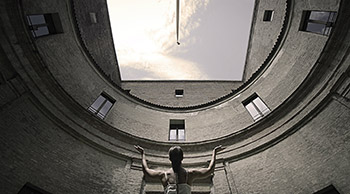
First scene: Conflicts
In her Notebooks, Simone Weil wrote that “Each true statement is an error if its opposite is not thought of at the same time, and it cannot be thought of at the same time”. The mediation of contradictions is only an altered image of the irreconcilable polarities that, instead, make up reality. But thinking about the unthinkable leads us to a place that reason has never managed to penetrate. To be exact, it leads us to atopy, to “that absence of a place” that offers us a different measurement of the world.
Second scene: A Border
A limit, a boundary. A prison, an earthy and opaque shell. This is the body Plato talks about in Phaedo, inaugurating philosophy as an act that ought to put the body itself to death by blocking the “barbaric mud” of the passions enclosed in it. But do there exist borders that are not, as Melville said, porous or frayed? Does there exist a final border that we cannot cross?
Third scene: Extremes
Perhaps it was Novalis who first thought of an atopic knowledge, of a knowledge that does not dwell in any defined place. Due to this he had to hypothesise a limit that was not a boundary between the things of the world but was inside the things themselves: “… to fluctuate between extremes that it is necessary to unite and divide. From this point of view, every situation is sparked off by this fluctuation …”.
Fourth scene: Vertigo
Man is the being who knows about his own death. He carries it within himself like a bud or like a vice. Eros, Thanatos, and the body. Perhaps this is the vertiginous odour that the embraced bodies feel in the depths of their respiration. Bodies waiting for the end, as though the present were a limit that has in itself the pestilential topicality of death.
Fifth scene: Silences
Appearance does not hide the essence but reveals it in its very finiteness. A face chooses a mask, not to hide itself, but to reveal itself. At a certain point the truth of a mask meets the truth of the face over which it is placed, over the nakedness that the face could not bear. It is on that mask that my silent gaze rests, and the other at once becomes an object of my universe.
Sixth scene: Nudity
Albrecht Dürer, in a 1505 drawing, revealed absolute nudity: only a light hat keeps his hair above his wide-open eyes in this excessive vision without precedents. Rembrandt exposed his opaque face on which is reflected only the shadow of death. Egon Schiele pushed himself to a nudity that borders on flaying, almost as though only the lacerated body could have a meaningful relationship with the world. However, not all nudity is shameful and the bringer of scandal. It is so when in it there is an ostentation of our being, of our final intimacy.
Michele Manzini
Born on 1967. Lives and work in Verona, (Italy). For many years his art has been concentrated on the definition of figures that can suggest instability and conflict as unresolved elements. His work develops through the use of a wide variety of media, among which video, photography, installations, writing, and performances. He has exhibited his works in numerous shows and venues in Italy and abroad, among them the Italian Institute of Culture, Prague, 2009; MAXXI, Rome, 2009; SUPEC, Shanghai during the 2010 Expo; and the Venice Biennale in 2011 and 2013. His last video “Snags in Palladio” have been selected for important international festivals and have been screened at the Saitama Arts Theater in 2015; the Perez Art Museum Miami, 2016; the Lincoln Center for the Performing Arts in New York, 2016; the ZKM in Karlsruhe, 2017; the Nevada Museum of Art, 2017 and the Whitechapel Gallery, London, 2017. In 2009 he was awarded the Terna prize for contemporary art.
4:00
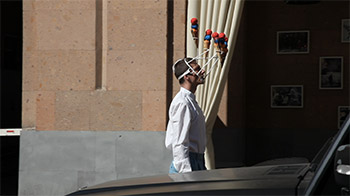
Melting Borders is a live performance which is shown as a durational piece or a walking street
action.
In Melting Borders I created a head-structure which holds 5 ice-creams.
Each Ice-cream is coloured with natural flavourings, which colours it of the color of the country I perform in.
The intention with Melting borders is to melt the political symbols and nationalistic components of countries and rather let shine the beauty of culture. The point of Melting Borders is to melt, with the witty presence of an ice—cream, every border, to let us discover the essence of culture, the sweetness of it.
In fact what remains on my white shirt is the colours of the flag and the shirt itself becomes like a painting, witnessing the melting process of the flag itself, achieving a “Sweet Flag”.
The Ice-cream becomes a symbol for peace, melting away war, Injustice, political symbolication of each country.
I so far collected performed in Armenia, Uk and South/North Korea. Conceiving and starting in during a residency in Yerevan, Armenia, then performing in an event at Toynbee studios, and South?north Korean border in Occasion of Pyeongchang Culture Olympics, DMZ art festa on the border with South and North Korea, collecting so far the tree shirts/flags.
I have chosen to use ice-cream for various reasons but also because it is internationally known the so called “developed society” and because it is internationally renown and loved by so many people, it can stay as the connector of global cultures.
Melting Borders was later performed in Uk at Toynbee Studios in London, uk and later at DMZ art Festa event organised by Pyeongchang Culture Olympics, 2018 on the border with South and North Korea, in Paju.
Riccardo Attanasio best known as “Matlakas” is a multidisciplinary artist born in 1982. After his degree in Sculpture obtained at University of Fine arts in Naples he moved to Uk where he studied
an MA in Social Sculpture at Oxford Brookes University.
Matlakas worked internationally including Moscow Biennale for Young Artists in 2010 and Gwangju Biennale in 2014, displaying his visual art and performance extensively in Europe but also in Palestine, South Africa, South Korea, China, Myanmar, Japan, Indonesia, Mauritius, Armenia, and Iran.
11:48
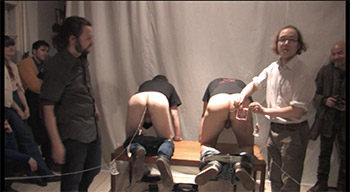
The MRCVE Artists Group was founded 2002 in Finland. The groups modus operandi is to openly
incorporate both scientific and artistic methods in its works. During its years of operation, it has performed in Europe and United States in addition to various single events in Finland. The State of the Nation I-III series has been presented in Helsinki, Malmö (Sweden), New York (US) and Berlin (GER). MRCVE has also collaborated with German artist Johnny Amore in two projects: 7 for the Price of 1 (a performance tour in Germany and the Netherlands 2010) and Operation Neuschwanstein (Germany 2008). Research results that group has collected have been published
as a book and videos.
During performances, which exploit the traditions of scientific presentation and performance art, the groups research projects take an artistic form as lectures transformed into theatrical spectacles. Documentations of these projects are realized through experimental media art. In a video screening, a viewer can find oneself part of a performance as images turn into flesh.
MRCVE are Jussi Matilainen, Asko Nivala, Janne Rahkila and Simo Saarikoski.
”State of The Nation” – Performance series by Messianic Research Centre for Visual Ethics.
”State of The Nation” is performance series that took part between 2010-2012. In this series MRCVE explored nations ability to confront alterity and understand their own roots. This happened in the act of performance, where MRCVE used audience as a manpower in test situation environment. ”State of The Nation” Also took deep look to analyze fundamental localisation of nationalism and took detailed action to reveal it’s basics.
Every single performance of the series was culturally related to its location and formed the whole ensemble which is functionally in all possible circumstances throughout the world. State of the Nation parts I-IV took place in Helsinki/Finland, Malmö/Sweden, New York/USA & Berlin/Germany.
08:14
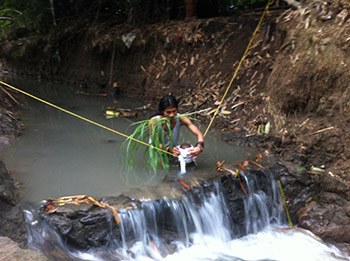
Human has already been numb for decades by destroying the nature in consciousness. Their mind as a capitalist prefer to be controlled by the thirst-desire to conquer the ecosystem.
Ecosystem has been ruined by the capitalist. Field rice and trees have been replaced to the houses and skyscrapers. The air is hotter now. City park construction ruin the nature’s structure, the trees are gone and change into small pretty plants. Kids find no more big field surrounded by trees to play and lay down.
The death of the plants are caused by the irresponsible people, then illegal logging kills all over the ecosystem and earth is getting hot. We call it now global warming. Could our children later see and live among the lashing trees or futuristic tall buildings.
I am an Indonesian performance artist, now i live in small crowded city named Bandung. I was born on June 20th 1992. This year is my final year at the university and i take Indonesian Literature as my major. But in 2012 i started to learn and do some performances besides my routine as a literature student. Once i performed that was the moment i thought this thing i would be curious to learn all my life ahead. And yes until i am typing my bio, i still do performance art. In 2017 was the hectic year for me and memorable. I joined group of performance artist in Bandung “Koloni Hitam”. Then i was taking part performance art studies; Selat Sunda Study, 112 Kongkorongox. Most of the performance art i did hold in other cities. Sofia Underground Exhibition would be my second time of my performance art presented as a documentation. My performance art are most likely as symbol that speaks or written like texts that became a story which people seeing not just by reading. My performance art work that would be presented at Sofia Underground Exhibition titled “Analgesia” or Analgesic. I relate the environment in to my body, where i am a human has already numb and can’t feel anymore. So “I” make lot of destruction to the nature. People can see my work by their own perspective, how numb are you, human?
14:59

“Teriact” is “Teri” and “Act” combined. The former refers to anchovies in Bahasa Indonesia and the latter is an English verb that refers to well, act. Together, they are to be pronounceable as “TERIAK”, the vocabulary referring to the act of screaming.
Teriact is a current social representation of the commonplace that is intensely influencing and burdening the world’s order as a result of humans’ careless actions. This observation has affected my mental condition to the point where I can no longer differentiate what is right or wrong- not that it even matters in the first place. Everything has become visually blurry and it is very difficult to speak and act accordingly.
Humanity is slowly eroding, incapable to be on par with the fast developing modern era. It has changed the way we behave- as it may seems, constantly is turning for the worse. Solidarity and our sensitivity towards community is slowly vanishing. We are like gunpowder. A slight exposure to fire is capable of extreme annihilation.
I am left speechless, rendered useless. I simply observe and constantly yet passively anxious. My eyes see but my mouth and muscle are tight. I am silent or to be precise, mute. I have ran out of words, ran out of energy, filled with agony yet my tears won’t flow. Apathy is not a choice yet surrender is inevitable. I am stuck in a rapid stream, simply floating away.
Graduated from Jakarta Pedagogy University, faculty of arts. I have been actively making performance art since 2003. Till today I am an independent performer, organising festival in Jakarta (Padjak Festival), members of the Rewind Art Community. I’m interested in the exploration of the body and space,within the connection with momentary based.Performance art as the media to understand the intuition, and gave it the freedom. Interpret something and assemble them into an unexpected situation, to guide and mediate the will of the soul to the body, and the surrounding. I believe that sometimes performance art can work as a therapy, for the thirsty soul,for honesty following the intuition.
10:55
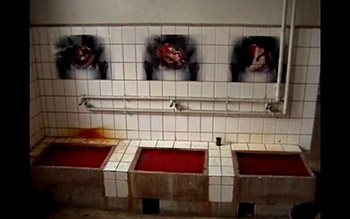
The video contains three separate parts united with common concept, but realised in different time:
video – 1998
performance 1 – 1999
performance 2 – 2008
tandem OS are Orlin Dvorianov (Bulgaria) & Stella Intchovska (Germany/Bulgaria).
Professor Orlin Dvorianov is among the artists who have laid the foundations of Bulgarian contemporary art. From the mid-1970s to the 1980s, he organised and participated in the actions of avant-garde groups Kukuv Den and De. They are one of the first to do public space actions, happenings and performances. Constant participant at Sofia Underground, Dvorianov is also founder of Art in Action Association which has done countless performances in and outside Bulgaria of the past 25 years. He still leads performance art classes at Sofia University.
Stilla Inchovska is based in Dresden, Germany. Member of the Art in Action Association, she is a Dvorianov’s long time collaborator and active performance artist.
05:00
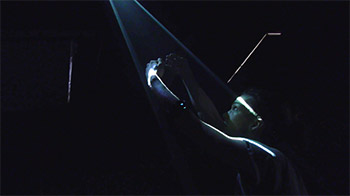
test no.1
We enter a dark room and encounter a presence in the space: projected light sculptures on the floor that are fluid, moving and mutating in form, and yet solidly demarcating the territory of the space.
Their form has no obvious logic at first, it is strange and uncanny. The only immediate point of reference in the environment is the looped formation of the Cartesian grid on the wall, disrupting the fluidity of the immersive space. The performers, each individual in their own right, yet pedestrian all the same, approach the light sculptures. As they begin to approach the forms, carefully moving around and within the light sculptures, a common language between the movement of the performer and the sculpture begins to emerge.
Upon closer look, we can see the performers are wearing medical grade Electromyography (EMG) sensors on their arms. In their performative gestures, it becomes apparent that their actions are causing the light sculpture to move, and we become aware that the extraction of their biodata is implicated in the process. Their biodata reads from the EMG sensor are translated in realtime by a machine learning algorithm, represented in a constantly moving and mutating light sculpture form influenced by feedback from the performers’ movements. But the algorithm doesn’t just respond, it attempts to predict what comes next, and the performer must mediate this encounter, finding new ways to move with it. The performers are in essence interacting with a sculptural manifestation of their unique “data selves”.
The project emerged through a long research process about how machine learning algorithms are impacting the construction of our movement, choices and subjectivity. Through looking at the materiality of data that comes from us, and what can now be called a “data self ”, the project analyses how the physical subject and the data-self subject are mutually constructed. The project is on-going and informed by each performance (or “testing session”). The documentation shown here is the first testing session between the machine learning algorithm and the performers. Over the course of the next year, multiple iterations of the performance will occur, and evolve and change as the relationship between performer and algorithm grows.
Monica Tolia is an interdisciplinary artist working in choreography, dance and score, computation, installation, sculpture and sound. She works collaboratively with dancers, electronic musicians and programmers, creating immersive performances that reflect on the proliferation of computational processes in physical spaces, and how it impacts human embodiment. She is currently a final year student on the MFA Fine Art at Goldsmiths, University of London.
“Thinking through Brian Massumi’s notion of “lived abstraction” (Semblance and Event), I am interested in how abstract systems of power operate upon bodies in the neoliberal environment through various forms of spatialisation: the urban, planetary computation, and the network. Using already existing principles in choreographic practice and my background as a dancer, I think through how various power dynamics (the social, the institutional, the state, the financial, the computational) reinforced by the algorithmic are influencing patterns of movement, shaping subjectivity and creating probabilistic determinisms that influence our present. I call my analysis of this process and its real world effects the choreography of power.”
25:49

NUTRICULA started in Shanghai in 2015 as a solo performance that aims to create raw physical language and influence audiences directly with a bare minimum of elements: no costumes, sets, music or lights. NUTRICULA’s strategy was to liberate the body and the physical actions it produces from the meaning that’s imposed on them. NUTRICULA puts the performer into intensive physical struggle with himself to test and re-imagine the limits of the body.
NUTRICULA is today a growing archive which invites performers from different backgrounds to collaborate on the same concept and dramaturgical structure. The work intends to bring performers to a specific state-of-mind by inviting them to follow simple rules – 1. explore the different body parts as objects separate from their function 2. test their limits. Initially a collaboration with an artist from Ghana, the project fell apart due to visa issues in both China and Europe. The continuation of the work with other performers in different contexts was a reaction to the political and economic conditions artists face today. What interests me in the re-production of this work is the tension between global and local within the performer’s body, the way the socio-political background and the biography are changing the form and the way the performer claims space within the strict concept. The resulting archive is a rejection of the capitalist imperative of constant production of new material instead replaced by recycling of the same form in a variety of versions,shaped by the identity of each collaborator. In the process we are uncovering how a global economic system shapes the way we live, produce and reproduce and how we react to it on a local level, limited by our own bodies.
Educated in the theatre academies of Sofia and Shanghai, I started my practice with two poetry collections transformed into live spoken-word shows, followed by five theatre plays: The Walled In Ones (2012, Nikolay Binev Theatre, Sofia), Borgestriptych (2014, Swatch Art Peace Hotel, Shanghai), Elevation 506 (2015, readings and workshops at Theatre Drachengasse, Vienna; Red House, Sofia; Drama League of New York), Ishmael (2016, Nau Ivanow, Barcelona) and Erasmegidio (2017, Quartieri dell’arte festival, Italy). Since 2014 I’ve been working on NUTRICULA, a physical performance research which represents a growing archive of solo works interpreted by performers from different backgrounds and produced and presented in various locations around the world: Shanghai, Vilnius, Lisbon.
05:30

Bedtime Ritual for Suffragettes uses stylized speech and a choreographed sequence of gestures to investigate the ambiguity of political action and inaction in the Internet Age. Motivated by protests to protect the rights of workers—broadcast as global spectacles on the Internet—the piece is a ritual embodying the tense relations between labor, art, movement, and taking to your bed. After all, what’s a girl to do when “there are beasts that sleep with both eyes open, and they set their sights on our rightful place”? What do we do with an Internet that never sleeps? Perhaps we should start dreaming from the wrong place and see what happens.
Bedtime Ritual for Suffragettes is a darkly humorous exploration of the struggle between doing and not doing. At the same time, it makes an impassioned and sincere plea for all of us to consider the extent and the limits of our inaction. It was originally broadcast live via UStream as part of the exhibition Low Lives 3. Notably, the video intentionally captures the impact of an unpredictable wireless Internet on the broadcast image, which is, at times, (beautifully) pixelated.
Heather Warren-Crow is an artist based in Lubbock, Texas in the US who specializes in both live and media-based performance. Most recently, she presented performance art at World Stage Design in Taipei (Taiwan), Glasshouse in Brooklyn (US), and Counterpath Gallery in Denver (US); theatre at the Porsgrunn International Theatre Festival (Norway); design at the Prague Quadrennial (Czech Republic); video art at the Northwest Film Forum in Seattle (US) and the Institute of Visual Art in Milwaukee (US); and sound art at the Museum of Performance + Design in San Francisco (US), Spring/Break Art Fair in New York City (US), Compliance Division Project Space in Portland (US), and the PNEM festival of sound art in Uden (The Netherlands). She is currently artist-in-residence at the laboratory of biophysicist Sy Redding at the University of California, San Francisco. Information about her creative work can be accessed at http://www.heatherwarren-crow.com/creative-work.html. Warren-Crow is assistant professor of interdisciplinary arts at Texas Tech University.
06:44

Frágil (vacío) is part of the Frágil project which investigates the physical and symbolic properties of Obsidian stones as a mysterious material used around the world in ancient times, connecting it with occult and political practices alike.
In these actions I looked for ways to generate visible fractures in obsidian mirrors, as dimensional portals for spiritual entities and as a metaphor to “destroy” heterotopias, these in between spaces, illusions, that which we can see but is not real. A visible “crack” in “reality”.
Alejandro Zertuche (1989, Monterrey, Mexico) Visual artist & independent arts manager, graduated in Visual Arts from UANL and along with Melissa Garcia is co-director of Venus Project, performance art platform, he has presented his work in different exhibitions and performance art festivals around Mexico and Cyprus, Colombia, Italy, Dominican Republic, Venezuela, Finland, Poland, Peru, Chile, Spain, Paraguay, Brazil, Indonesia and India.
He has been part of platforms such as Biosfera Experimental and Performance Art Studies, as well as appearing in publications like Emergency Index Vol. 5, DISPERSION, and LARMAGAZINE. He was a fellow of the Young Creators 2016-2017 program in México’s National Fund for Culture and Arts with the project “Frágil” and is currently part of the editorial board of the emerging art magazine from Monterrey “Fea International”.
His artistic practice can be located in an autobiographical vision that he links with an independent study of occultism and mysticism, frequently exploring the capacity of ritual in performance art, linking processes to generate video, sound and installation experiments.
Пърформанси:
27.04.2018
@ Sofia Arsenal Museum For Contemporary Art (4, Cherni Vrah Blvd)
Ten for Hundred
29.04.2018
@ Electro-control center, National Palace of Culture
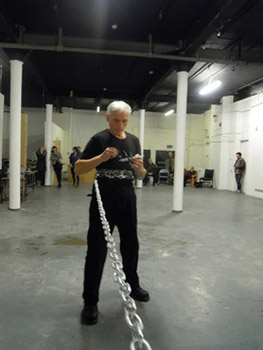
Born in 1955 in Odzaci, Serbia (Ex-Yugoslavia).
Freelance visual and performance artist, publisher and curator.
Member of art societies of Vojvodina (SULUV) and Serbia (ULUS).
From 1984 to 1988 founded and published alternative international art magazines “Total” and “Second Manifesto”.
Curator of various international art projects and exhibitions since 1980. 1998. he founded of Multimedia Art Studio and MAS Gallery in Odzaci, Serbia. Organiser and curator of International Multimedial Art Festival – IMAF.
Since 1980 Nenad realized his over 250 art performances and art actions on many international art projects and festivals worldwide (France: 1994, 2011, 2012 & 2013, Italy: 1995, 2003, 2004 & 2011, Slovakia: 1996, Germany: 1996, Japan: 1997 & 2008, Romania: 1998, Poland: 1999, 2007, 2010, 2012 & 2013, Hungary: 2001 & 2011, Belarus: 2001, United Kingdom: 2004 & 2010, Northern Ireland: 2004 & 2011, Switzerland: 2004, USA: 2005, Canada: 2006 & 2008, Turkey: 2007, Israel: 2007, and in Serbia (since 1980).
Realised art tours with Man Gallery project in France 1994, Italy 1995, Germany 1996, Japan 1997 and Switzerland 2004.
In 2003 year realised two art performances on 50th International Biennial of Venice-Italy (International Art Project: Brain Academy Apartment).

Valko Chobanov was born in Plovdiv in 1991.
In 2014 he graduated with a BA from the Scenography program of the Academy of Music, Theater and Dance Arts in Plovdiv. Currently he is getting an MA degree in Digital Arts at the National Academy of Arts in Sofia, Bulgaria.
Valko works in the fields of painting, illustration, media arts and performance art. He has participated in a lot of group exhibitions in Bulgaria and abroad.
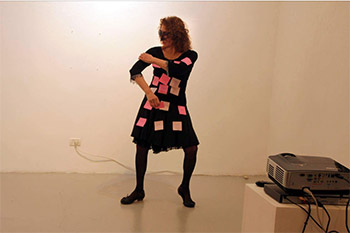
In the age of Facebook the virtual Feed Wall is the body longing for real connection and touch which makes things disrupted.
Eva Dabara is a multi-disciplinary artist, poet, performer and dancer, born in Israel, lives and works in Tel-Aviv. She studied Philosophy and English literature at Tel-Aviv University, art, photography and video at Camera Obscura and performance art The Performance Platform in Tel-Aviv. She has published 3 books of poetry, won literary prize and participated in anthologies and numerous art magazines.
An adventurous year in the Caribbean Islands was followed by the poetry book “Paradise Episodes” which eventually formed her second solo exhibition “Bermuda Triangle” – a minimalist installation confronting the stereotype images of a tropical island, and the tension between reality and fantasy.
Using photographs, text, video, objects and ready-mades Eva Dabara creates a syntax which reveals a conceptual yet personal drive juxtaposing the concrete and the imaginary, verbal and visual, low and high art. Zigzagging between the different elements and media she explores an eclectic world of diverse existence which is at times dramatic, absurd, humorous, hallucinated, poetic or mundane.
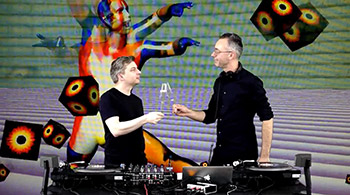
Specially invited for the opening party of Sofia Underground the Stuttgart based scientists Julian Friedauer and Iassen Markov will premiere their live performance Divine Design, which is one third of the Technobeton project.
• 100% Divine
• 100% Design
• 100% Pixel
• 100% Julian Friedauer
• 100% Iassen Markov
• 200% Iasselon Friedendoorp
• 100% Techno
• 100% Beton
• 100% #meganice = 1000% 0711
http://www.0711blog.de/0711tape-12-technobeton-divine-design-mixtape/
https://www.facebook.com/technobetonier.dich.official/
budalasultan
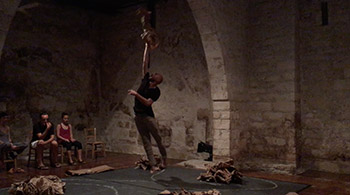
(ancient greek, philosophy) Contemplation of one’s own self. (en.wiktionary.org) A trip to wondering yourself and being a witness to yourself. Transformation of the relationship between the actant and pursuer to words, body, object and drawing. An intention to understand yourself through insight and open it. A desire for seeing and being visible. “…experience for knowledge, wonder for experience, heal in disease, transformation of body, one is a process, one is a process…”
Enstasis is produced as a choreographic performance work through Viewpoints (contemporary composition methodology) and Dance Movement Theraphy methods.
It includes original free writing texts and drawings about subjects of existence of human being, identity, free will. The materials are composed in a physical way. All of the physical shapes, sounds and words are originally created by Safak Ersozlu, the artist of the work.
Concept and performance: Şafak Ersözlü; Devising: Şafak Ersözlü, Bahar Nihal Ersözlü
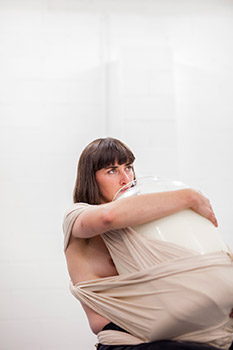
In a review written by the Polish art critic Małgorzata Kaźmierczak, she describes Léann Herlihy’s performance practice as “avoiding banal narration”, continuing to describe me as “an artist, which we all have full belief in”.
Léann Herlihy is a performance artist based in Ireland. Her practice attends to the intersection of invisible power structures; addressing the position of the female body as a focal point of repressed histories and political desires. Herlihy’s performances are raw, as she pares back her gestures to pure bodily instinct and improvisation. In her work, clothing is regarded as an object rather than a consecrated costume – simultaneously concealing and exposing the performance artist. Enigmatic in form, she often accentuates these objects in relation to her body, exploring their history as she sieves through their multiple readings. The use of endurance in Herlihy’s practice
highlights the exaggerated protraction of time, all of which becomes enhanced by the symbiotic relationship with the audience; where the very act of their continued observation, in itself becomes a ritualised behaviour.
WHAT NOW, NOW WHAT? // A RESPONSE
We’re at an awkward stage in society. Simultaneously we’re living the death of civilisation and feeling birth pangs of a new retrogression, experiencing more the former than the latter at present. It’s a time for perseverance and insight, turning whatever negatives we can into positives. Many feel without an identity. As an inverted negative, external difficulties may for us to tap deeper sources of identity and personal worth within ourselves and our cultural context than we’d normally be ‘required’ to dredge up, call forth or invoke. If and when we can make this ‘transition’, advantage is there.
What now, now what? Waiting. Why is it important? We more often think of art as proactive, as doing something that we want to do, telling others something that we need to express, showing them something that we understand. But how is it possible to make a response if one doesn’t allow the world to enter and affect one in some way? No discovery happens without being open to that which is unknown and once that collision with the unknown occurs, change happens… this is how we learn, and it is the only way that we grow, by adjusting our thinking in light of new information. The encounter with something new may seem minor, but it is never insignificant.
There’s conflict. It’s up to artists not to get downtrodden, but to retain ‘edge’. We’re innovators and instigators, individually and collectively, and shouldn’t allow the ‘outside’ manipulators to dictate our development. There are real consequences to every action in which one engages. Any action affects one both physically and psychologically. It is happening by and to one’s body, and its impact cannot be discounted simply because it is called art.
Performance art is not an investment object. The work cannot be separated from the maker. It cannot be held. It cannot be saved. It cannot be reproduced. Performance art reveals the vulnerability of the living. Since the work cannot be separated from the body who makes it, a number of questions continually surface about the medium of performance art.
What is true is that a live action can be generated nearly instantly in response to a situation, and it can happen anywhere. The performance artist is able to infiltrate and respond to a broad range of contexts. Neither witness nor artist knows the outcome in advance, rather they arrive at it together. The experience is visceral.
Meanwhile, life does not stop while art occurs, so how are the two melded within an action? Why do we even want to make a distinction between life and art? One of the most compelling aspects of doing performance art is the opportunity to practice fully living in the moment. When one’s senses are fully engaged and one’s awareness is heightened, time slows down, and a kind of out-of-body experience occurs. The thrill is being able to shape it, control it, while being near the point of sensory overload. If everything is in tune, the experience can create a kind of ecstasy, and, with that, a sense of timelessness occurs. In other words, one feels, at least for that moment, omniscient and immortal. And at the very same moment one also perceives the nature of time. One becomes acutely aware of the immediate loss of the moment that has just passed, of the disappearance of the work, of the fading of the memory of the work, and the eventual vanishing of one’s self. Nothing remains.
The record of performance art resides in the bodies of the artists and the witnesses. They are committing a portion of their lives that they will never recover, in order to be present for an action that has not yet happened. They also serve as the artist’s eyes, reflecting back what has happened. They can verify that the action occurred, since they were witness to it, even after all the physical evidence of it has disappeared. In turn, the artist is aware of the viewers watching, feeling their response to what is happening, seeing it through their eyes. This can create a heightened sense of awareness for the artist, making them feel both inside and outside the action simultaneously.
All are sharing the same amount of time passing, inhaling the same degree of oxygen in the air, adjusting to the same temperature in the room, smelling and tasting the same odors, and hearing the same sounds. Only those who were there truly understand, and even then one discovers discrepancies. As viewers compare notes in retrospect, they discover that each had a unique experience. No one remembers everything, nor in precisely the same way.
This constant reminder of the ephemerality is humbling. It keeps one anchored in the reality of the moment, in feeling the profound limits of one’s body, and conscious of the fragility of time, the specific qualities of the place, and the uniqueness of the witnesses.
We are only here. It is only now.
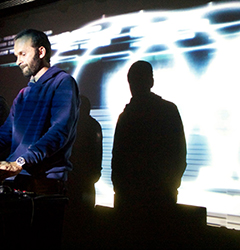
Sair Sinan Kestelli is a sound artist living and working in Istanbul. Combining his engineering background with sound design and sonic arts studies, his practice focuses on electronic music composition, performance and new digital musical instrument design. His work is part of the record Anthology of Turkish Experimental Music: 1961–2014 (2016), released by Sub Rosa Records. He attended various electronic music events in Istanbul, Ankara, Frankfurt, Lisbon, New York, Amsterdam and Skopje with his work (e.g. Musica Viva Festival, Desonanz Festival, Steim Instrument Lab). He also contributes to contemporary dance and performance projects by different choreographers as sound designer. Kestelli is currently a PhD candidate at Istanbul Technical University Centre for Advanced Research Studies in Music (MIAM) Sonic Arts Program and part of the electronic music duo Mondual.
At Sofia Underground 2018, Sair Sinan Kestelli will collaborate with local artist YvesO performing together at the closing act of the festival.
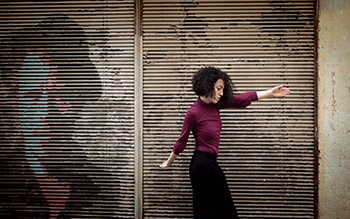
Performance is shaped by the space in which the body is located, and it re-interprets gaps. It examines the relationship between the body’s presence and absence and the traces of these relations. Traces of voids, voids of traces, hanging in the void, shaping with spaces, shaping voids … Or just a simple dance performance. To the void in us, to the void in which we are …
Serenay Oğuz graduated Yildiz Technical University, Music and Stage Arts, Contemporary Dance Department.
She staged her works named “ODAK” (Focus) and “”YUKLENIYOR” (Loading…) as dancer and coreographer.
Other than her formal education, she took part in many workshops and projects given by contemporary artists such as Akash Odedra, Alma Toespern, Kathryn Hamilton, Leyla Postalcioglu.
Since 2014 she’s taking Body Dramaturgy and Action Design classes as a guest student in Kadir Has University and working on the relationship between theatre, movement and dance.
She’s giving Movement Workshops since September 2014 in Istanbul.
She’s giving contemporary dance classes since 2012.

(Directory Board Member, Visibility In Arts Festival – Izmir)
Culture manager, producer, event designer and composer. Founder of many pioneering bands on Turkish independent music scene; since 1993, he performed with and produced various bands and projects blending rural blues, free jazz, concrete music, collective impro, noise and funk. Since 1996, he composed music for performing arts and contemporary arts projects, radio dramas and state theaters. Since 2013, as a founder member of Initiative for Izmir Culture Pla+form, he masterminds on culture policy while supplying consultancy for independent venues and festivals.
During the festival Sofia Underground Sarp Keskiner will have a workshop with local musicians trohi and KaNZ. Together they will experiment with ideas, sound equipment and creative approaches towards live performance. They will prerecord a promo music release and present it in a collective impro performance at the electro-controll center on the 29th of April.
http://www.muzikhayvani.com/red-abizianas.html (solo)
http://www.muzikhayvani.com/saska-2.html (saska)
http://www.muzikhayvani.com/skip-lakes.html
http://www.muzikhayvani.com/noksan.html (noksan)
An attempt to trigger the self-awareness of audience as agent.
An exploration of the passage of the subject through the liminality between non-art and art.
An attack on the “gallery border”.
Dimitar Velkov is an artist, writer and educator from Dimitrovgrad, Bulgaria. His work has been screened, exhibited, and performed at The Museum of Modern Art in Chicago, Sofia Design Week, The Fuller Dome Home,
the Little Muddy Festival among others. He is recipient of the Fulbright grant and has a Master’s in New Media from Southern Illinois University, where he spent the last two years making art, and teaching Screenwriting.
+ инсталации, разговори с артисти & партита
Местоположения:
НГ / Софийски арсенал – Музей за съвременно изкуство
Електро-контролна зала – Национален дворец на културата

- Chun Hua Catherine Dong (CA) – The Sign (2017)
- Felipe Bittencourt (BR) – BICHO (2017)
- Michelle Manzini (IT) – In the House of Mantegna (2017)
- Paddy Cahill (IR) – Amanda Coogan: Long Now (2015)






